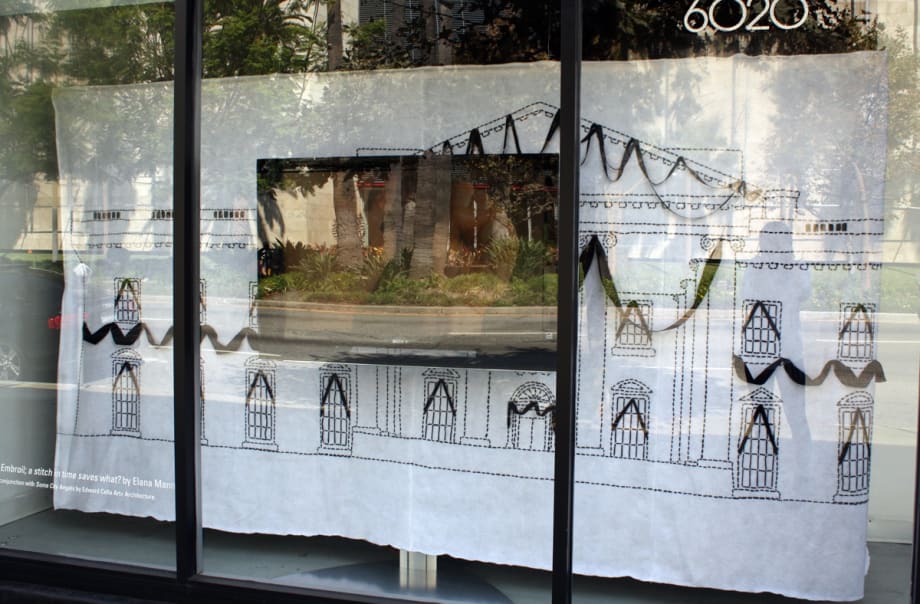Elana Mann: Embroid, Embroil; a stitch in time saves what?
Edward Cella Art & Architecture is pleased to present Embroid, Embroil; a stitch in time saves what? a site-specific public installation by Elana Mann presented in conjunction with the ECAA exhibition, Some City Angels.
The original performance, Embroid, Embroil, took place on September 11, 2007 in Valencia, CA. The artist, dressed in an affectation of a first lady character, stitches the contemporary icon of torture and “othering” into the palm of her hand. The performance lasted for one hour. At the end of the performance, the artist pressed her stitched hand into the palms of each audience member. The performance deals with how torture of prisoners of war has become normalized in the United States, and how the images of torture penetrates into the surface of everyday life, symbolized by the surface of our hands. In the piece, the artist transforms herself into a modern day Betsy Ross, or female politician, revealing the ways that women have suddenly shifted from onlookers of war and torture to perpetrators of violence.
Edward Cella Art & Architecture is pleased to present Embroid, Embroil; a stitch in time saves what? a site-specific public installation by Elana Mann presented in conjunction with the ECAA exhibition, Some City Angels.
The original performance, Embroid, Embroil, took place on September 11, 2007 in Valencia, CA. The artist, dressed in an affectation of a first lady character, stitches the contemporary icon of torture and “othering” into the palm of her hand. The performance lasted for one hour. At the end of the performance, the artist pressed her stitched hand into the palms of each audience member. The performance deals with how torture of prisoners of war has become normalized in the United States, and how the images of torture penetrates into the surface of everyday life, symbolized by the surface of our hands. In the piece, the artist transforms herself into a modern day Betsy Ross, or female politician, revealing the ways that women have suddenly shifted from onlookers of war and torture to perpetrators of violence.
Now, ten years after 9/11 and four years after this performance was originally staged, in its reconfigured and equally compelling format, Embroid, Embroil; a stitch in time saves what?, Mann asks, how have these issues shifted or not?
Elana Mann is a multi-disciplinary artist whose practice encompasses performance, video, installation and objects, in addition to discursive and collaborative projects. Mann is drawn to the way performance makes pure critique impossible; the presence of the artist’s own body immediately implicates her in whatever she is challenging. Her recent focus on the embodiment of socio-political fantasies/realities stems from broader questions about the capacity for contemporary empathy, the potentials of transformative dialogue, and ways art can initiate societal shifts.
Mann has presented work at REDCAT, Los Angeles; Apex Art, New York; Galerie Califia, Horazdovice, Czech Republic; A Gentil Carioca, Rio de Janeiro; Jancar Gallery, Los Angeles; and Outpost for Contemporary Art, Los Angeles. She is a recipient of California Community Foundation’s 2009 Visual Arts Fellowship and has published five books, including: We are the Art (2010) and Exchange Rate: 2008 (2009). Four of Mann's books are in the collection of the Getty Research Institute. Currently, Mann is a Visiting Lecturer at Scripps College, Claremont, CA. Mann received her B.F.A. from Washington University, St. Louis in 2003 and her M.F.A from California Institute of the Arts, Valencia, CA in 2007.

